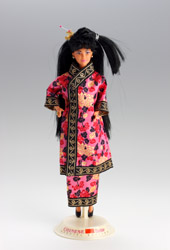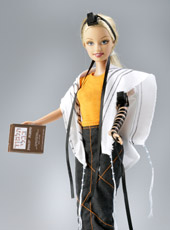That’s So Cliché
Permanent link All Posts

A doll featured in the exhibit, from the International Barbie Dolls (Dolls of the World Series © Mattel, Inc), from the collections of Bettina Dorfman and Barbie-Klinik Düsseldorf
As a little girl, Elizabeth Gelman’s daughter would describe everyone by the color of clothes they were wearing. She would say, “That purple lady over there is talking to that green man.”
Like the little girl, children often learn how to classify through this sort of exercise. But somewhere along the way in society, as children grow into adults, differentiating between people sometimes morphs into stereotyping.
“There’s a difference between recognizing the differences and stereotyping people—putting people into categories and thinking that is where they belong,” said Gelman, the manager of education for the Spertus Museum at the Spertus Institute of Jewish Studies in Chicago.
A new exhibition at the museum, entitled “Twisted Into Recognition: Clichés of Jews and Others,” explores the ways images and objects that depict stereotypes are seen, perceived, and classified. Organized by the Jewish Museum Berlin and the Jewish Museum Vienna, the exhibit runs in Chicago from Sept. 26-Jan. 18.
The show does not deny ethnic or cultural differences, but rather explores how stereotypes about these differences are conveyed. “Stereotypes and clichés are an integral part of our perception, shaping our image of ourselves and others as well as our sense of belonging to a distinct group or nation apart from others,” said exhibit co-curator Dr. Felicitas Heimann-Jelinek. “At the same time, they can serve as a breeding ground for racist ideologies. The exhibition aims to raise consciousness about how we interpret and evaluate with every glance, and how we need to question our ‘point of view’ over and over again.”
Heimann-Jelinek, senior curator for the Spertus Museum and chief curator of the Jewish Museum Vienna, curated the exhibit with Hannes Sulzenbacher, a curatorial specialist in Austria. After premiering in Berlin earlier this year, the show's September arrival marks the start of its only American stop. Following its run at Spertus, the show will travel to Vienna.
Most of the stereotypes in the multimedia exhibit are presented in a triptych format, a series of three panels: an item that historically illustrates the stereotype, a familiar example of the stereotype from culture and a contemporary artistic response.

A page from a 1938 Nazi schoolbook regarding the stereotype of the Jewish nose
For example, consider the stereotype that Jews have big noses. First, the exhibit displays an image from a 1938 Nazi schoolbook of a child looking at a drawing on a blackboard of an old man with a large nose wearing a Jewish star. The caption of the image translates to “The Jew’s nose is bent at its tip. It looks like a six.” Second, the triptych features Viennese walking sticks from the 1800s with handles made to look like hook-shaped noses. Finally, in the artistic response to the stereotype, the painting “Before and Happily Ever After,” by American artist Deborah Kass, plays with stereotypes and obsessions about beauty by reproducing Andy Warhol’s image of a woman’s profile before and after plastic surgery.

Jen Taylor Friedman's Tefillin Barbie
The exhibit also features “Tefillin Barbie,” a Barbie doll sporting tallit (prayer shawl) and tefillin (phylacteries) reading from a Torah. The Barbie is the creation of Jen Taylor Friedman, a Jewish ritual scribe from England, who is the first woman known to have completed a Torah scroll. Her doll has garnered mixed feedback from the public, being called everything from “disgusting” to “incredibly amazing.”
Friedman recognizes the need to classify people, but wishes human beings could do so in a less destructive way. “The world is a great big complicated place and there is only so much space you can hold so it helps to label people,” she said. “It would be nice if we could use less-destructive labels, if a Jewish label could not mean the grasping guy with a gigantic nose, but could be the nice person who goes to shul.”
Multiculturalism has become a feel-good buzzword in recent years, but Gelman says it’s important to wrestle with the more squeamish topics too. “Sometimes we get lulled into this contentment talking in generalities about multiculturalism and diversity and that is the feel-good conversation,” she said. “But discussions of race and ethnicity have to include conversations about discrimination, prejudice, and stereotypes too. While those discussions probably are more uncomfortable, they are really important. We hope that one day racism will be a relic of a very distant past, but we need to recognize it in order to move forward.”
“Twisted Into Recognition: Clichés of Jews and Others” runs Friday, Sept. 26-Sunday, Jan. 18, 2009. A free public preview will be held Thursday, Sept. 25 from 5:30-8. Docent-led tours for both students and adults are also available. For more information, visit
www.spertus.edu
or call (312) 322-1700.



.jpg)



